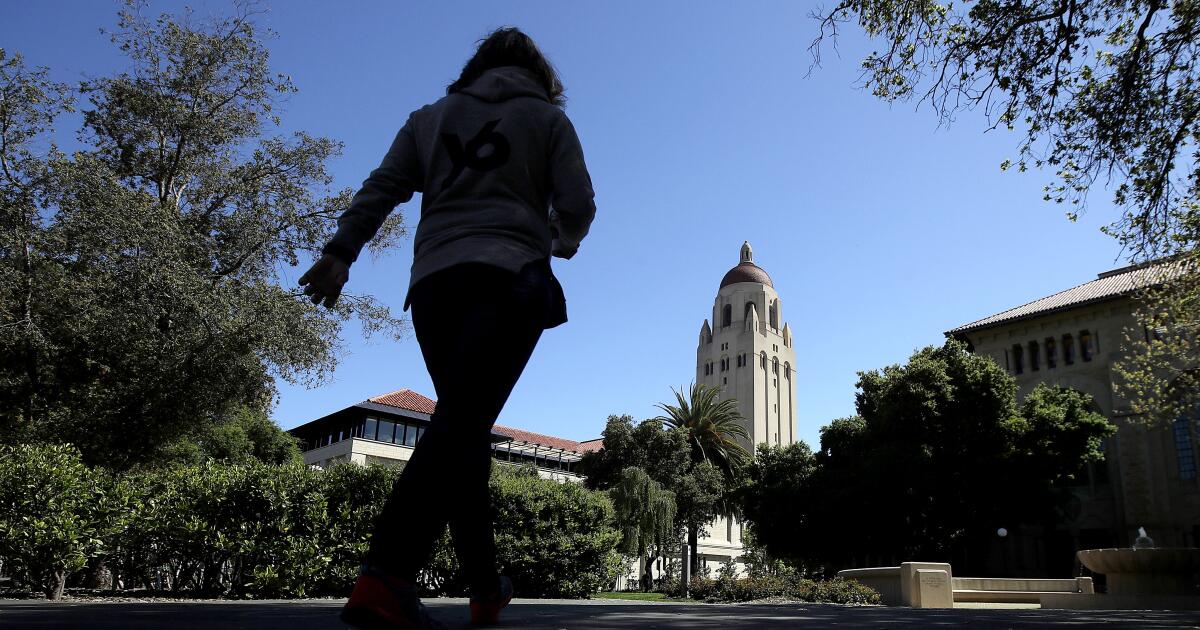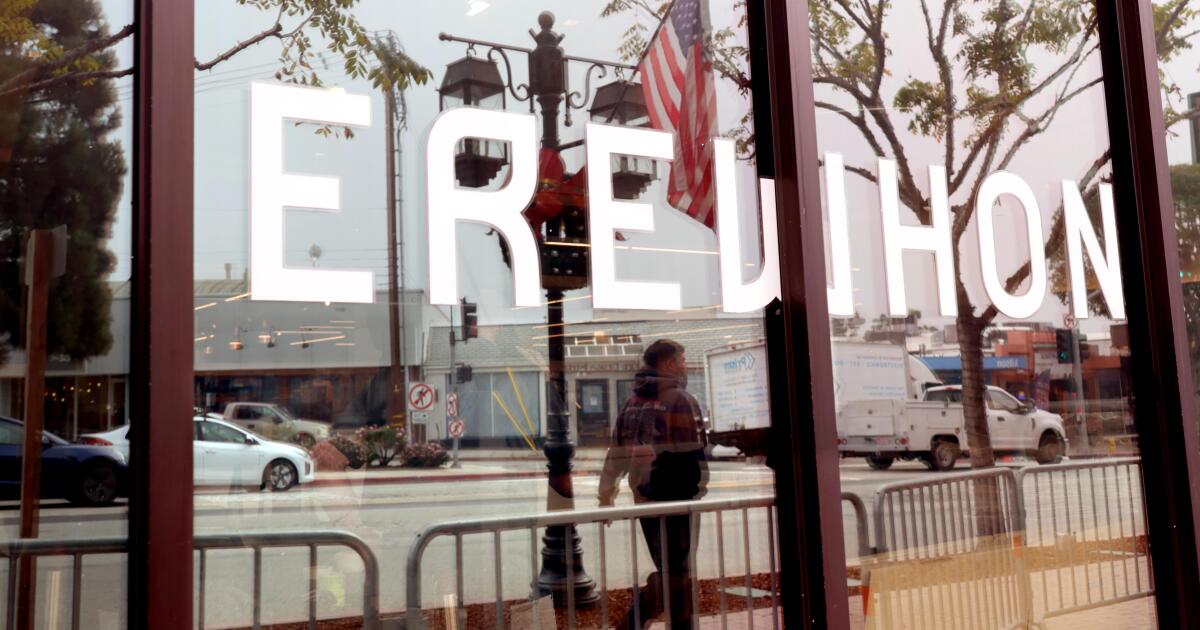Business
Netflix says ad-supported plan now has 70 million monthly active users

Netflix said Tuesday that it had reached 70 million monthly active users on its ad-supported plan, two years after launching its cheaper subscription tier that includes commercials.
That’s up from May, when the company reported having 40 million monthly users on the ad version.
The Los Gatos, Calif., streamer has also been diversifying its content, including increasing its streams of live events, in order to boost its nascent advertising business.
Netflix said it had sold out of the in-game inventory for its live NFL Christmas Day games this year, with sponsors that include sports betting company FanDuel and Verizon. The streamer has partnered with Nielsen to provide live ratings for the games.
Netflix also said it had sold ads across its scripted programs, including the anticipated second season of the Korean drama “Squid Game.”
The company said that more than half of new sign-ups in countries where Netflix offers ads are for the cheaper ad-subscription tier.
“There has been continuous momentum over the last two years, but we’re just getting started and can’t wait to see what’s to come,” Amy Reinhard, president of advertising, said in a blog post.
Netflix began offering a cheaper ad subscription plan in November 2022 after the streamer saw its subscriber growth in decline earlier that year. In the U.S., Netflix with ads cost $6.99 a month, compared to ad-free options that start at $15.49 a month.
At first, Netflix’s ad-supported tier was powered by Microsoft’s technology through a partnership, but the streamer is transitioning to using its own in-house ad technology which will make it function independently from third parties.
The ad-supported tier was part of a broader push to diversify Netflix’s offerings and boost revenue. In addition to commercials, Netflix has started streaming live events, cracking down on password-sharing and promoting games on its platform.
This week, Netflix will up its live sports ambitions with a boxing match between former heavyweight champion Mike Tyson and influencer-turned-fighter Jake Paul.
Netflix in the third quarter added 5 million subscribers, bringing its total to about 283 million globally.

Business
They graduated from Stanford. Due to AI, they can’t find a job

A Stanford software engineering degree used to be a golden ticket. Artificial intelligence has devalued it to bronze, recent graduates say.
The elite students are shocked by the lack of job offers as they finish studies at what is often ranked as the top university in America.
When they were freshmen, ChatGPT hadn’t yet been released upon the world. Today, AI can code better than most humans.
Top tech companies just don’t need as many fresh graduates.
“Stanford computer science graduates are struggling to find entry-level jobs” with the most prominent tech brands, said Jan Liphardt, associate professor of bioengineering at Stanford University. “I think that’s crazy.”
While the rapidly advancing coding capabilities of generative AI have made experienced engineers more productive, they have also hobbled the job prospects of early-career software engineers.
Stanford students describe a suddenly skewed job market, where just a small slice of graduates — those considered “cracked engineers” who already have thick resumes building products and doing research — are getting the few good jobs, leaving everyone else to fight for scraps.
“There’s definitely a very dreary mood on campus,” said a recent computer science graduate who asked not to be named so they could speak freely. “People [who are] job hunting are very stressed out, and it’s very hard for them to actually secure jobs.”
The shake-up is being felt across California colleges, including UC Berkeley, USC and others. The job search has been even tougher for those with less prestigious degrees.
Eylul Akgul graduated last year with a degree in computer science from Loyola Marymount University. She wasn’t getting offers, so she went home to Turkey and got some experience at a startup. In May, she returned to the U.S., and still, she was “ghosted” by hundreds of employers.
“The industry for programmers is getting very oversaturated,” Akgul said.
The engineers’ most significant competitor is getting stronger by the day. When ChatGPT launched in 2022, it could only code for 30 seconds at a time. Today’s AI agents can code for hours, and do basic programming faster with fewer mistakes.
Data suggests that even though AI startups like OpenAI and Anthropic are hiring many people, it is not offsetting the decline in hiring elsewhere. Employment for specific groups, such as early-career software developers between the ages of 22 and 25 has declined by nearly 20% from its peak in late 2022, according to a Stanford study.
It wasn’t just software engineers, but also customer service and accounting jobs that were highly exposed to competition from AI. The Stanford study estimated that entry-level hiring for AI-exposed jobs declined 13% relative to less-exposed jobs such as nursing.
In the Los Angeles region, another study estimated that close to 200,000 jobs are exposed. Around 40% of tasks done by call center workers, editors and personal finance experts could be automated and done by AI, according to an AI Exposure Index curated by resume builder MyPerfectResume.
Many tech startups and titans have not been shy about broadcasting that they are cutting back on hiring plans as AI allows them to do more programming with fewer people.
Anthropic Chief Executive Dario Amodei said that 70% to 90% of the code for some products at his company is written by his company’s AI, called Claude. In May, he predicted that AI’s capabilities will increase until close to 50% of all entry-level white-collar jobs might be wiped out in five years.
A common sentiment from hiring managers is that where they previously needed ten engineers, they now only need “two skilled engineers and one of these LLM-based agents,” which can be just as productive, said Nenad Medvidović, a computer science professor at the University of Southern California.
“We don’t need the junior developers anymore,” said Amr Awadallah, CEO of Vectara, a Palo Alto-based AI startup. “The AI now can code better than the average junior developer that comes out of the best schools out there.”
To be sure, AI is still a long way from causing the extinction of software engineers. As AI handles structured, repetitive tasks, human engineers’ jobs are shifting toward oversight.
Today’s AIs are powerful but “jagged,” meaning they can excel at certain math problems yet still fail basic logic tests and aren’t consistent. One study found that AI tools made experienced developers 19% slower at work, as they spent more time reviewing code and fixing errors.
Students should focus on learning how to manage and check the work of AI as well as getting experience working with it, said John David N. Dionisio, a computer science professor at LMU.
Stanford students say they are arriving at the job market and finding a split in the road; capable AI engineers can find jobs, but basic, old-school computer science jobs are disappearing.
As they hit this surprise speed bump, some students are lowering their standards and joining companies they wouldn’t have considered before. Some are creating their own startups. A large group of frustrated grads are deciding to continue their studies to beef up their resumes and add more skills needed to compete with AI.
“If you look at the enrollment numbers in the past two years, they’ve skyrocketed for people wanting to do a fifth-year master’s,” the Stanford graduate said. “It’s a whole other year, a whole other cycle to do recruiting. I would say, half of my friends are still on campus doing their fifth-year master’s.”
After four months of searching, LMU graduate Akgul finally landed a technical lead job at a software consultancy in Los Angeles. At her new job, she uses AI coding tools, but she feels like she has to do the work of three developers.
Universities and students will have to rethink their curricula and majors to ensure that their four years of study prepare them for a world with AI.
“That’s been a dramatic reversal from three years ago, when all of my undergraduate mentees found great jobs at the companies around us,” Stanford’s Liphardt said. “That has changed.”
Business
Disney+ to be part of a streaming bundle in Middle East

Walt Disney Co. is expanding its presence in the Middle East, inking a deal with Saudi media conglomerate MBC Group and UAE firm Anghami to form a streaming bundle.
The bundle will allow customers in Bahrain, Kuwait, Oman, Qatar, Saudi Arabia and the UAE to access a trio of streaming services — Disney+; MBC Group’s Shahid, which carries Arabic originals, live sports and events; and Anghami’s OSN+, which carries Arabic productions as well as Hollywood content.
The trio bundle costs AED89.99 per month, which is the price of two of the streaming services.
“This deal reflects a shared ambition between Disney+, Shahid and the MBC Group to shape the future of entertainment in the Middle East, a region that is seeing dynamic growth in the sector,” Karl Holmes, senior vice president and general manager of Disney+ EMEA, said in a statement.
Disney has already indicated it plans to grow in the Middle East.
Earlier this year, the company announced it would be building a new theme park in Abu Dhabi in partnership with local firm Miral, which would provide the capital, construction resources and operational oversight. Under the terms of the agreement, Disney would oversee the parks’ design, license its intellectual property and provide “operational expertise,” as well as collect a royalty.
Disney executives said at the time that the decision to build in the Middle East was a way to reach new audiences who were too far from the company’s current hubs in the U.S., Europe and Asia.
Business
Erewhon and others shut by fire set to reopen in Pacific Palisades mall

Fancy grocer Erewhon will return to Pacific Palisades in an entirely rebuilt store, as the neighborhood’s luxury mall, owned by developer Rick Caruso, undergoes renovations for a reopening next August.
Palisades Village has been closed since the Jan. 7 wildfire destroyed much of the neighborhood. The outdoor mall survived the blaze but needed to be refurbished to eliminate contaminants that the fire could have spread, Caruso said.
The developer is spending $60 million to bring back Palisades Village, removing and replacing drywall from stores and restaurants. Dirt from the outdoor areas is also being replaced.
Demolition is complete and the tenants’ spaces are now being restored, Caruso said.
“It was not a requirement to do that from a scientific standpoint,” he said. “But it was important to me to be able to tell guests that the property is safe and clean.”
Erewhon’s store was taken down to the studs and is being reconfigured with a larger outdoor seating area for dining and events.
When it opens its doors sometime next year, it will be the only grocer in the heart of the fire-ravaged neighborhood.
The announcement of Erewhon’s comeback marks a milestone in the recovery of Pacific Palisades and signals renewed investment in restoring essential neighborhood services and supporting the community’s long-term economic health, Caruso said.
A photograph of the exterior of Erewhon in Pacific Palisades in 2024.
(Kailyn Brown/Los Angeles Times)
“They are one of the sexiest supermarkets in the world now and they are in high demand,” he said. “Their committing to reopening is a big statement on the future of the Palisades and their belief that it’s going to be back stronger than ever.”
Caruso previously attributed the mall’s survival to the hard work of private firefighters and the fire-resistant materials used in the mall’s construction. The $200-million shopping and dining center opened in 2018 with a movie theater and a roster of upmarket tenants, including Erewhon.
“We’re honored to join the incredible effort underway at Palisades Village,” Erewhon Chief Executive Tony Antoci said in a statement. “Reopening is a meaningful way for us to contribute to the healing and renewal of this neighborhood.”
Erewhon has cultivated a following of shoppers who visit daily to grab a prepared meal or one of its celebrity-backed $20 smoothies.
The privately held company doesn’t share financial figures, but has said its all-day cafes occupy roughly 30% of its floor space and serve 100,000 customers each week.
Erewhon has also branched out beyond selling groceries.
Its fast-growing private-label line now includes Erewhon-branded apparel, bags, candles, nutritional supplements and bath and body products.
Erewhon will also open new stores in West Hollywood in February, in Glendale in May and at Caruso’s The Lakes at Thousand Oaks mall in July 2026.
About 90% of the tenants are expected to return to the mall when it reopens, Caruso said, including restaurants Angelini Ristorante & Bar and Hank’s. Local chef Nancy Silverton has agreed to move in with a new Italian steakhouse called Spacca Tutto.
In May, Pacific Palisades-based fashion designer Elyse Walker said she would reopen her eponymous store in Palisades Village after losing her 25-year flagship location on Antioch Street in the inferno.

Fashion designer Elyse Walker announced the reopening of her flagship store at the Palisades Village in May.
(Myung J. Chun/Los Angeles Times)
“People who live in the Palisades don’t want to leave,” Walker said at the time. “It’s a magical place.”
Caruso carried on annual holiday traditions at Palisades Village this year, including the lighting of a 50-foot Christmas tree for hundreds of celebrants Dec. 5. On Sunday evening, leaders from the Chabad Jewish Community Center of Pacific Palisades gathered at the mall to light a towering menorah.
A total of 6,822 structures were destroyed in the Palisades fire, including more than 5,500 residences and 100 commercial businesses, according to the California Department of Forestry and Fire Protection.
Caruso said he hopes the shopping center’s revival will inspire residents to return. His investment “shows my belief that the community is coming back,” he said. “Next year is going to be huge.”
-

 Iowa5 days ago
Iowa5 days agoAddy Brown motivated to step up in Audi Crooks’ absence vs. UNI
-

 Iowa6 days ago
Iowa6 days agoHow much snow did Iowa get? See Iowa’s latest snowfall totals
-

 Maine3 days ago
Maine3 days agoElementary-aged student killed in school bus crash in southern Maine
-

 Maryland5 days ago
Maryland5 days agoFrigid temperatures to start the week in Maryland
-

 Technology1 week ago
Technology1 week agoThe Game Awards are losing their luster
-

 South Dakota5 days ago
South Dakota5 days agoNature: Snow in South Dakota
-

 Nebraska1 week ago
Nebraska1 week agoNebraska lands commitment from DL Jayden Travers adding to early Top 5 recruiting class
-

 Sports1 week ago
Sports1 week agoPro Football Hall of Famer Troy Aikman critiques NIL landscape, transfer rules and Lane Kiffin’s LSU move



















